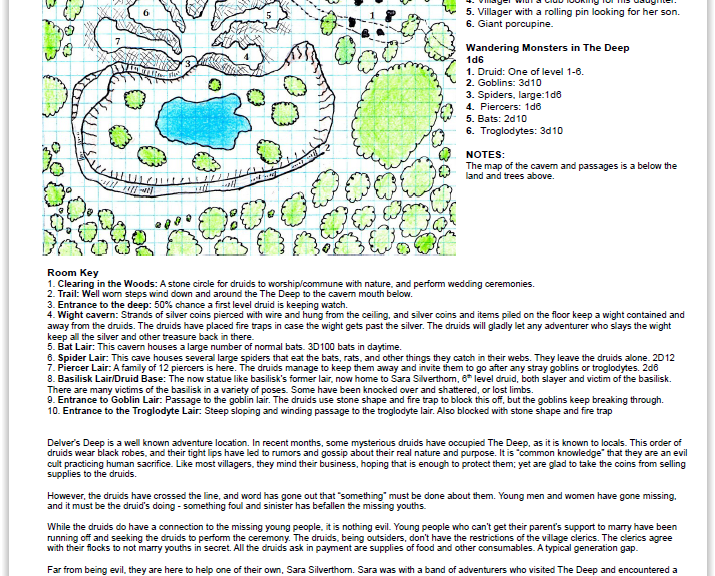U – Unusual – Sites, sights, sounds, smells, etc. See DMG tables for dungeons for ideas.
What is unique about this city? What sets it apart from the others?
Is it a tourist or pilgrimage destination?
Is it the site of a famous battle, a famous magical occurrence, wizard dual, undead invasion, etc?
What is so interesting or special about this place that it would bring the player characters here? Why should they care about this magnificent work that you have labored over for hours, days, and perhaps weeks? In short, so what?
In my campaign, I had an NPC advise them not to go to the ancient city because I did not have it ready. I finally made some rough plans and ideas, and they said they were headed to the city, but kept making detours, then we have not played. This series has been me fleshing out ideas, and making some charts and tables to help me with this city or any of the other ancient cities around the fallen empire. I can also use this to help with a new setting of various genres, not just fantasy.
A city can be a place where the town, wilderness, and dungeon meet. A city has all the “civilized” aspects, plus all the odd things that can happen there. The wilderness can encroach on the city, when a monster or group of crazed animals enter the city. The city may have lots of unexplored spaces underground, sewers, cellars, etc.
A city gives the opportunity to have multiple cultures interacting. Players can find a job, find someone or something they are looking for, or get into more trouble or find some injustice or other happening that they can act on now and be delayed in getting to the dungeon, or act on later when the consequences of failing to act now are played out.
Cities present the image of civilization, is it only a skin-deep veneer, or does it permeate the mindset of its denizens? Does what this city considers acceptable behavior something strict and uptight, or something more nebulous, or perhaps something frightening to the truly civilized?
Cities of any size will have a dark underbelly. How easily can this be found? Does it infiltrate all levels of society, a single general neighborhood, or only those places that you must know where to look?
Every genre of RPG, fantasy, science fiction, etc. has a place for cities. Some claim that you can’t have good adventures in cities, other claim you can’t have good adventures or good campaigns without them. I say, it all depends on the desire of the players and the skill of the GM.
Cities can be a place of refuge and safety, or they can be a bottomless pit of danger.
Things happen in cities that rarely or never happen anywhere else. It’s hard to have a riot in a thorp of 20 people. At least, what we tend to think of as a riot. Under a certain size, it is hard for anyone to avoid the prying eyes of everyone in town. If you have ever lived in a small town, you know what it is like to live in the fishbowl of everyone knowing your business, sometime before you know it. For certain illicit activities, it is difficult to keep it under wraps without a large number of the town knowing about it. Unless it is the kind of town where everyone is in on it, a science fiction/horror movie like Invasion of the Body Snatchers, where strangers are shunned, rushed out of town, or incorporated into the population, small towns won’t have some of the activity found in cities.
Cities of a large enough area and population can have all manner of things occurring. Smuggling, drugs, prostitution, murder, robbery, and other violence, graft, and intrigue. Certain things may not be illegal, like drugs and prostitution, merely frowned upon by the “respectable people”. Of course, some of them are hypocrites in secret. Is it truly a secret, or a known thing, but never spoken of type secret?
If there is a thieves guild, how organized are they? A newer guild may only focus on the small scale robbery and break ins. A more established guild, or one with a more thoughtful guild master might find a way to gain wealth without drawing the ire of the guards, or figure out how to bring the guards into it, etc.
The black market will require someone to bring in the illicit things, whether they be items prohibited from import from an enemy country in war time, or items that require a high tax, or items that are illegal for some reason.
Will there be any cities that are so unusual that there is no thieves guild and the party thief exhausts his knowledge of thieve’s cant, and still can’t make contact? Would this be a population under mind control, truly free of crime, or pulling a fast one on all newcomers?
Is there a zoo, menagerie, museum, or other site to see in this city? Would the wild animals from the zoo of a fallen city have descendants roaming about? Perhaps a pride of lions, a troupe of monkeys or apes, or even something more fantastic.
Would there be some item or artifact of the ancients on display in a living city, or would a fallen city hold the mundane and marvelous items of the forgotten past? This is something where fantasy, science fiction, horror, and apocalyptic genres all converge. The ancients had things no longer used or understood. Things that can change the course of events in the current time. In AD&D this is represented by the Artifacts and Relics in the DMG, in Metamorphosis Alpha this is represented by the forgotten technology that is found and perhaps put to a helpful use.
+Adam Muszkiewicz’s city of Ur-Hadad is a mixture of all kinds of weird and unusual. Rugs made there have some strange property that hold information that can only be understood by a few. Some of this, I am sure he comes up with at the table as it happens, and other stuff he has notes for ideas. Use whichever works for you.
Make a list of what is unique or special about this city.
- Why was this city founded?
- Why is is located here?
- What is the one thing this city is/was known for?
- As with +Jeff Rient’s 20 Quick Quetions for Your Campaign Setting about the greatest people, monsters, and so forth in a campaign, do the same for your cities.
- What are the major imports/exports of the city?
- Where is/was the largest/most valuable gem, treasure, magic item located?
- What is the predominate architecture of the city?
- What is the craziest rumor you will hear? Is it true?
- Anything else you feel is needed to bring this city to life at the table. Review my prior posts on cities in this A to Z Challenge for other ideas for your cities, like Entrances & Exits.
- Ask the players for their ideas, use them then and there, or save them for later.
The unique, unusual, distinctive bits and bobs you attach to your cities help bring them to life, and make them different, so that while cities have some aspect of sameness to them, they are not all cookie cutter duplicates. The same should be said of dungeons. While they are all underground, there should be something different about them. All the tombs in a series of barrows might be nearly identical, except one has more traps, or more undisturbed traps, or more wealth, or better construction, etc. Likewise, all the cities of an empire spread across hundreds of miles might all have common elements, but relative age and local culture will add their own distinctiveness. As with everything else in RPG’s it is expected to steal ideas, that is, gain inspiration, by borrowing from reality.
What can you learn about real ancient cities, or current cities? What twist can you find to put on like cities, or what quality or aspect of cities can you “swap out” to make each one distinctive? Even if running adventures in living cities is not your thing, such embellishments will help make your dead cities more real.
For example, Kansas City, Missouri, is called Cow Town, for all the stock yards that were the end point of cattle drives, once the rail head moved west from Sedalia. Large stockyards have a distinctive odor. If you have ever driven by a modern stockyard, you get the idea. The direction of the wind, and location of the yards will influence how far the smell travels and how strong it is.
Rome is called the City of Fountains for all of its fountains. The list could go on.







